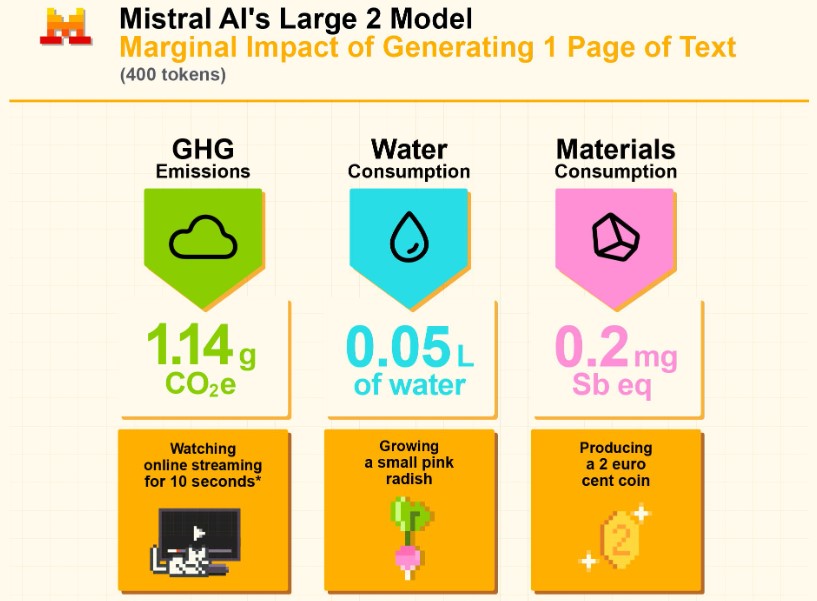As artificial intelligence continues to advance at a remarkable pace, an important and positive conversation is emerging about its environmental footprint. The call for greater transparency is growing, signaling a collective move toward a more sustainable future for AI.
Pioneering efforts have seen companies like Google release data on the lifecycle emissions of their AI hardware1. Building on this momentum, a recent paper, Misinformation by Omission: The Need for More Environmental Transparency in AI contributes to this constructive dialogue. It highlights the exciting opportunity for the industry to develop more standardized and transparent reporting methods.
By working together to better understand the energy involved, we can transform potential blind spots into areas for innovation. This allows everyone, from developers to end-users, to be part of building a more efficient and environmentally conscious AI ecosystem as we embrace these powerful new technologies.
Mistral: A Pioneer in Peer-Reviewed Transparency
In a significant move toward greater accountability, French AI company Mistral published a detailed, peer-reviewed report on the environmental impact of its Mistral Large 2 model: Our contribution to a global environmental standard for AI | Mistral AI. The lifecycle analysis provides concrete numbers on the model’s footprint after 18 months of usage:
- Total Training Impact: The model’s creation generated 20.4 kilotons of CO₂ equivalent and consumed 281,000 cubic meters of water.
- Per-Inference Impact: A single 400-token response from its AI assistant, Le Chat, generates 1.14 grams of CO₂ equivalent and uses 45 mL of water.
By opening their methodology and results to external scrutiny, Mistral has taken a vital first step in creating a more transparent and accountable AI ecosystem.

Google’s Deep Dive into AI Inference
Following Mistral’s lead, Google also contributed to the conversation with a technical paper on the environmental impact of its AI, focusing specifically on the inference phase—the process of using a trained model to generate an output: Measuring the environmental impact of AI inference | Google Cloud Blog. Google’s report offers a detailed look at the resource usage of its Gemini models, highlighting the remarkable efficiency of its systems.
The paper provides specific figures for a median Gemini Apps text prompt:
- Energy: 0.24 watt-hours (Wh)
- Carbon Emissions: 0.03 grams of CO₂ equivalent
- Water Consumption: 0.26 milliliters (mL)
The authors attribute this efficiency to a “full-stack” approach that includes everything from custom-built hardware (TPUs) to highly optimized software and data centers. This holistic approach is a valuable lesson for the industry, demonstrating that significant environmental gains can be made by optimizing every part of the AI pipeline.
The Road Ahead: Challenges and Opportunities
While the contributions of both Mistral and Google are commendable, they also highlight the challenges of creating a standardized approach to environmental reporting in AI. Experts have pointed out2 that different companies may use different methodologies, making direct comparisons difficult.
For example, some of the points raised in relation to Google’s report include:
- Indirect Water Usage: The report focuses on direct water usage for cooling, but doesn’t account for the water used by power plants to generate electricity, unlike Mistral.
- Carbon Accounting: The use of market-based emissions, which allow for offsets, can paint a different picture than location-based metrics that reflect the local grid’s carbon intensity.
- Comparisons: Comparing median results with averages from previous studies, or comparing on-site water consumption with lifecycle totals, can be misleading.
It is also important to note that, unlike Mistral’s report, Google’s paper was an internal study and does not appear to have been peer-reviewed.
A Call for a Greener AI Future
The reports from Mistral and Google are a positive sign that the AI industry is beginning to take its environmental responsibilities seriously. To build a truly sustainable AI ecosystem, however, we need a commitment from all stakeholders to embrace transparency, adopt standardized reporting, and invest in research that prioritizes efficiency. The future of AI is not just about building more powerful models, but about building them in a way that is responsible and environmentally sound.